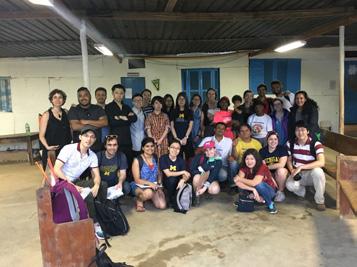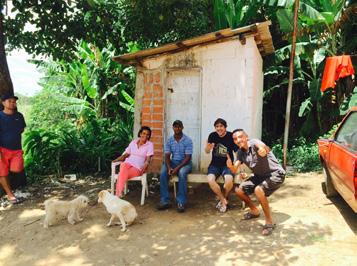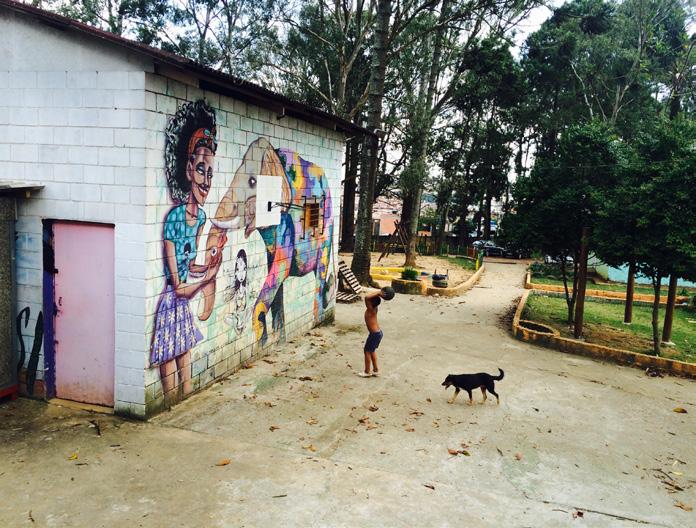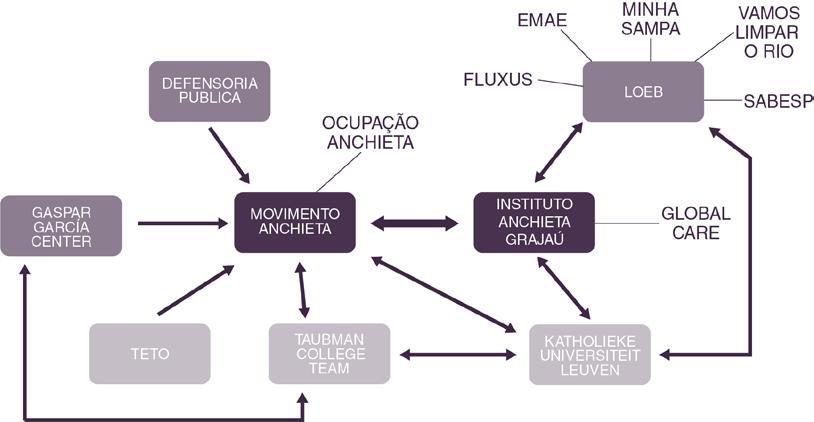
6 minute read
Stakeholder Analysis
14


15 16

17
18

22 14 Instituto Anchieta Grajaú (IAG) Facilities. 15. IAG Basketball Court. 16. Informal Gathering. 17. Students and Partners. 18. (from left to right) Moacir, Ana Paula Pimentel Walker, Anderson, Unknown Resident, Elizabeth, Fernando, Two Children, María Arquero de Alarcón.
STAKEHOLDER ANALYSIS
Ocupação Anchieta exists within a complex web of stakeholders. The Movement plays a role in attracting support for Ocupação Anchieta from outside parties, such as NGOs (i.e. TETO), the public defense (defensoria publica), organizational centers (Gaspar Garcia Center for Human Rights) and universities like Taubman College at the University of Michigan.
The Taubman College Team first met the property owners, Instituto Anchieta Grajaú (the Institute) (IAG), during the March 2017 fieldwork visit. Instituto Anchieta Grajaú is a non-governmental organization (NGO) dedicated to a holistic approach towards youth education and development. The NGO provides after school programs for four hours per day to 600 children in Grajaú. For IAG, environmental protection is the next highest priority after serving vulnerable children and youth.
The land on which Ocupação Anchieta is located was initially owned by Cyrela, a real estate company active in the area. Originally, a developer had planned to build 2,500 houses on the 62-acre plot, but was unable to do so because the area included 250 square meters of protected land surrounding the creek and springs. In 2001, Cyrela donated the land to IAG, for education programming in the Grajaú district. The Institute had recognized the lack of access to housing, education and arts in the southern area of the city of São Paulo and, through community engagement, sought to provide services and activities for residents.
Although IAG built temporary structures to house their educational and recreational activities, the conservation land around the creek had remained undeveloped up until the time of the land occupation in 2013. However, the land was informally used as an illegal dumping site. Occupants built their homes (from scavenged materials) out of the need for housing without giving much consideration to environmental consequences.
The deforestation caused by the rapid settlement of people in the Occupation filled the NGO directors with resentment and IAG filed an eviction claim in court on August 15, 2013. The defensoria pública (public defenders) represented the Ocupação Anchieta Association when they were taken to court to be evicted from the land. Moreover, relationships with local Evangelical churches, such as the Assembly of God and other denominations provided support. A large network of social movements, which serve as a platform against evictions and support for land occupations in São Paulo, were also instrumental in assisting Ocupação Anchieta.
After several unsuccessful attempts to serve the eviction
1997
INSTITUTO ANCHIETA FOUNDED
2013
OCCUPATION BEGINS EVICTION LAWSUIT BEGINS (08/15/2013)
2014
2015
NEW RESIDENTS ARRIVE
2016
EVICTION CASE SUSPENDED (08/04/2016) UM FACULTY TRIP TETO NGO RELOCATES HOUSEHOLDS NEAR CREEK
2017
U OF LEUVEN STUDENTS ARRIVE UM STUDENTS TRIP EVICTION CASE SUSPENSION EXPIRES (08/23/2017)
19 Oçupacão Anchieta Timeline. order, the judge and the parts in the process agreed on August 2016 to suspend the legal proceedings for one year. The Institute and the dwellers agreed to temporary use rights for residents. The Institute has also agreed to open negotiations with the Association to come up with solutions to address the deforestation of the area and the accompanying pollution. The relationship between the Association and IAG is based on a mutual understanding that there must be a solution to preserve the conservation area and remedy the pollution there.
Instituto Anchieta Grajaú operates in collaboration with LoebCapote Arquitetura e Urbanismo (LoebCapote Architecture and Urbanism) (LOEB), which is an architecture firm founded in 1965 in São Paulo, Brazil. The firm is a convener of large development actors including engineering firms (fluxus); municipal services (Companhia de Saneamento Básico do Estado de São Paulo) (São Paulo, Brazil Water and Sanitation Utility) (SABESP); electricity and water companies (Empresa Metropolitana de Aguas e Energía S.A.) (Metropolitan Company of Waters and Energy) (EMAE); communication networks (Minha Sampa) (My Sampa); and Environmental NGOs (Vamos Limpar o Rio) (Let’s Clean the River). Architects, Roberto Loeb and Luis Capote, are the presidents of LOEB. Loeb is also the president of IAG. The architecture and urbanism firm also works directly with universities, such as KU Leuven, to help develop Ocupação Anchieta. In addition, IAG also volunteers with Global Care Health Solutions (Global Care) a health facility that provides home healthcare services.
Students from Katholieke Universiteit Leuven (University of Leuven) (KU Leuven), in Belgium, arrived three weeks prior to the Taubman Team to create a plan that is in line

20 Diagram of Agents Involved in the Program.
with IAG’s vision for the Occupation. Three KU Leuven students lived on IAG’s grounds and engaged residents through the use of interviews, surveys, and other methods to understand Ocupação Anchieta’s current condition. The Institute’s main vision that the KU Leuven project working toward is to recover part of the 200,000 square meters of conservation land lost through settlement by re-arranging existing and abandoned housing units. The proposal includes: a health center, market, permaculture, streets, sewerage and electricity systems.
The Institute would like to have the funds to transform the adjacent piece of land occupied by Occupation residents into temporary housing and a workplace colony to provide job training for families in need. The idea is that adults would gain professional skills and once inserted in the formal job market, families would move out, leaving room for new families in need of professionalization to move in. Furthermore, IAG has a vision for sustainable temporary housing and job training that embodies permaculture, replanting of trees, and green infrastructure, including communal sewage. Nonetheless, IAG does not yet have the funding to finance these innovative ideas. Furthermore, when the 800 families initially occupied the land, they did so with intention to build a permanent home and the Occupation.
Although the two sides disagree on specific aspects of land development, for the Occupation, there is a lot of cooperation between IAG and the Association. The points of disagreement include permaculture, the ideal housing size and prototypes, and the temporary nature of the proposed usufruct

21 Deforestation in Ocupação Anchieta from 2011 to 2016 (SOURCE: Google Earth Pro).
rights. Nonetheless, IAG has been working diligently on building consensus with the Association coordinators on these issues. Furthermore, Ocupação Anchieta residents deeply appreciate the social and educational services the Institute provides for the Grajaú District. For example, approximately 300 kids from the Occupation attend the after-school programs that IAG hosts for children throughout Grajaú. Furthermore, IAG has been pressuring the government to provide further medical services for the area in the future.
Taubman Team engaged in conversations with both the client-partner and IAG and a summary of the interviews appear in the methods chapter. As a result, the Team has strategically developed a framework that addresses the concerns of both parties, and embraces the housing and environmental conflict of the Occupation. Next chapter provides context for the Grajaú District and addresses the housing and environmental conflicts in Ocupação Anchieta as well as other informal settlements at the periphery of São Paulo.






